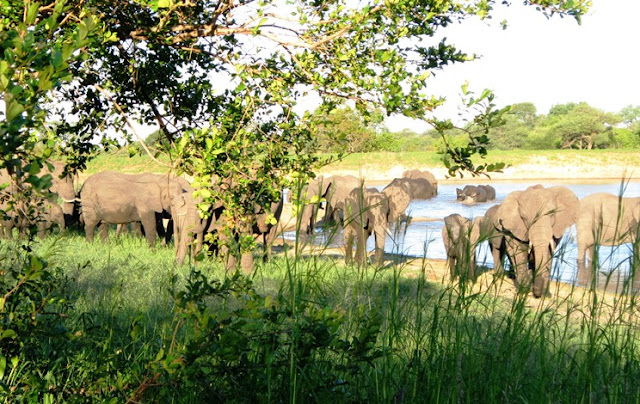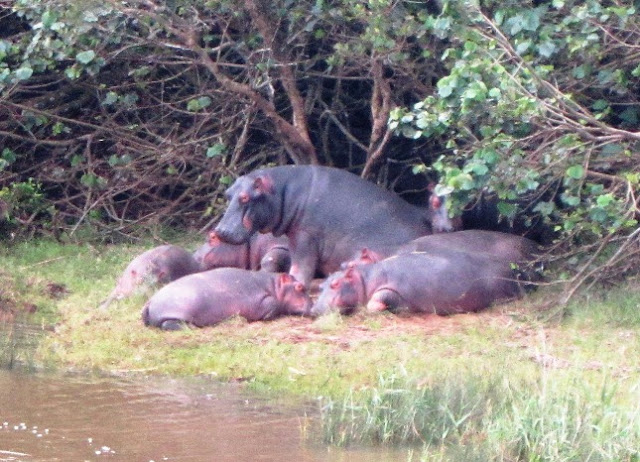South Africa and its neighbours are fascinating destinations and many (most?) cruisers take the opportunity to rent a car and head inland. You get a taste of what is to come in Richards Bay. There are lots of monkeys wandering around and there are even hippo crossing signs on the highway between the harbour and the town. We did two trips inland sharing our vehicles with an American couple, Lew and Ann who remarkably are also from Lake Ontario. They are members of Henderson Harbor YC on the eastern shore of the lake. They are very experienced cruisers having been on their boat for 16 years. From here they are going to Europe and want to spend the summer in Scotland. The following summer (2014) they plan to go down the Danube to the Black Sea.
 |
| Lew and Ann Tucker along with Bruce and June at a restaurant that served things like a shish-ka-bob on a hangar. |
We went to three parks for a total of 7 days of animal viewing. You really only need to go to Kruger National Park since you can see all of the animals there. I can't recommend a visit to this park too highly. It is a remarkable place to visit and a highlight of our cruise.
Don't go any further unless you want to see a lot of animal pictures...
 |
| This was our first encounter with large African wildlife. This white rhino was slowly wandering down the main road of iSimangaliso park right towards us. He got very close to us before realizing that we were there (they have terrible eyesight). They also don't seem terribly bright since it took him several seconds to figure out that we were also pretty large and that one of us would have to change course. He then veered to his left and passed us no more than 4 m away. |
 |
We also met these rhinos on a road, in this case quite a narrow one. You could almost imagine their thought processes as they went from, 'Hey, we wanted to go that way' to 'Well, I guess we will go this way instead.' The fight against rhino poachers is a very serious one as a few hundred rhinos are poached every year (the wild population of white rhinos is less than 20,000 while there are less than 5,000 black rhinos in the wild). To indicate the seriousness of the problem, one of the South African papers had the headline, "Poacher shot in ambush". We were lucky enough to see both although our good pictures are only of white rhinos.
|
 |
These African wild dogs that we saw in Hluhluwe-Imfolozi park are quite rare and considered endangered. There are only 3000 to 5500 of these animals in the world. We saw this pack of seven resting in the sun next to a waterhole. They have huge ears that they turn toward any sound that they hear.
|
 |
This guy is reputed to have the longest tusks of any elephant in Kruger NP. We managed to bump into him (well not literally) on one of our drives.
|
 |
| Large groups of elephants contain only females and children of various ages. You have to be very careful around such groups since the Moms are very protective. The park makes a point of displaying photos of cars that have been attacked by elephants.- a large elephant with its front legs on your roof will do more than damage the paintwork. Solitary males in heat are also dangerous - sort of like some guys I have known. We had one close encounter on a narrow road with an apparently agitated elephant and ended up leaving in a hurry. |






























1 comment:
Beautiful shots, you two.
You're making me feel better about our anticipated route already.
Post a Comment